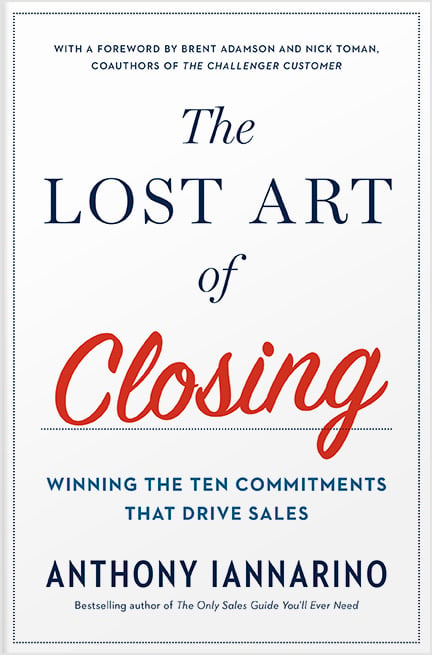Commitment #3, which you’ll find in The Lost Art of Closing: Winning the 10 Commitments That Drive Sales, is “the commitment to change.” We want our clients to change from our competitor’s solution to ours, something that would require them to replace our competitor with us. Creating a scenario in which these two things are possible—or even likely—means shaping the lens through which your clients see their business and decisions about their future.No more pushy sales tactics. The Lost Art of Closing shows you how to proactively lead your customer and close your sales. 
You can think of this process as “narrative warfare.” In Eat Their Lunch: Winning Customers Away from Your Competition, I show how to create a narrative that gives your client a compelling reason to change. That framework can massively improve your approach, starting with your prospecting and your first meeting, where you begin exploring change.Win customers away from your competition. Check out Eat Their Lunch
To shape your client’s decisions, you have to control the lens through which they see the limits of their current reality and the potential of their future. The reason so many legacy approaches to sales pale beside modern approaches is that they rely on strategies and factors that do nothing to shape the client’s lens. Here’s how to navigate the process.
No Better Results Available
We tend to get lulled into a sense of comfort when things go well for some time. That comfort is attractive, even though it almost always means that we are not reaching our full potential. The same principle applies to companies: an impression of doing okay keeps them from the better results they could reach if they knew what options were available. But the longer they embrace that comfort, the more likely it is to clash with a very uncomfortable reality, as the outside world continues to change with no regard for their consent or preference.
You can think of comfort as “the status quo” or “we’ve always done it this way,” or even “we’ve built our process on this approach.” The reason legacy approaches to discovery are much less effective than they were in the past is that they often assume that your client has a problem and you need to elicit that problem, mostly by asking what they would like to be better. But this approach doesn’t compel change, and when people don’t feel any pressure to change, they don’t.
Much of the time, your clients will believe that what they do is working, that better results are not necessary, or that there are no better results available to them. Like you and me, they can cling to the way they do things because they are comfortable—even when they are no longer useful. The first change you have to help your prospective clients make isn’t changing their solution or their chosen partner: it’s changing how they view their current state and their potential future state.
Controlling the Narrative
There is an advantage to living in a world of constant, accelerating, disruptive change, even if it seems chaotic: those changes highlight factors that previously went unnoticed or that your clients, knowingly or unknowingly, have refused to address. Often, by the time they recognize how much things have changed, they have fallen so far behind that it’s more difficult and expensive to make corrections.
One of the things you are responsible for as a consultative salesperson and as an aspiring trusted advisor is intervening to help your client—or your competitor’s client—recognize that their approach is already in conflict with reality, even if they are still getting the results they believe they need. You must help them recognize the need to change now, before the consequences of not addressing the changes wreak havoc with their results.
The narrative of the incumbent is that things are good, they’re under control, and there is no reason to change solutions or partners. The narrative of the insurgent is that the world is changing around you, whether you like it or not, so the results you are getting now are going to be more difficult in the future unless you change. But advisors don’t simply preach doom-and-gloom: they also provide a view of the better results that are available to their clients now.
Shaping those outcomes requires more than sharing your opinion, even though your opinion and your perspective are valuable to your client. It means providing the proof that what you say is true, including evidence from third parties. As Deming said, “Without data, you’re just another person with an opinion.”
The Lens You Are Providing Your Client
Legacy approaches to sales start with the idea that what’s really compelling to your client is your company’s story, even when it fails to provide anything of value to your client or their future results. The next story in the script is often about how another client had a certain problem that you solved for them.
Neither story effectively shapes the way the client in front of you views their current or future state or provides a compelling reason to change. It simply implies they have a problem without explaining the root causes, let alone the implications or negative consequences of standing pat, which is why many clients will explore change without actually committing to it.
The lens you need to provide starts with the factors that are already impacting your client’s business (or soon will be), unless they change what they are doing, how they are doing it, and who they choose as a partner. The salesperson who controls the lens through which their client considers their future decisions is almost certain to create and win a new opportunity. They also provide something that differentiates them from their competition by allowing them to create a higher level of value.

Get the Free eBook!
Want to master cold calling? Download my free eBook!
Many would have you believe that cold calling is dead, but the successful have no fear of the phone; they use it to outproduce their competitors.
Download Now







.jpg?width=768&height=994&name=salescall-planner-ebook-v3-1-cover%20(1).jpg)


